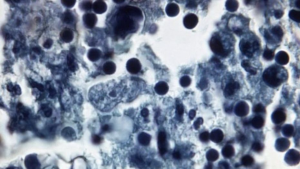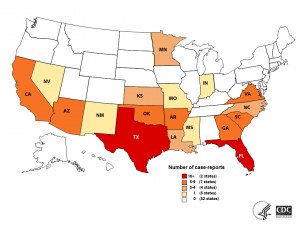 A young boy has died and officials in Louisiana have found a brain-eating amoeba called Naegleria fowleri, in the freshwater supply in a rural parish. Health officials claim the water is safe to drink. This is because the amoeba can only do damage if it enters the brain by being sniffed or snorted.
A young boy has died and officials in Louisiana have found a brain-eating amoeba called Naegleria fowleri, in the freshwater supply in a rural parish. Health officials claim the water is safe to drink. This is because the amoeba can only do damage if it enters the brain by being sniffed or snorted.
Naegleria fowleri causes a disease called primary amoebic meningoencephalitis (PAM), which is a brain infection that leads to the destruction of brain tissue. In its early stages, symptoms of PAM can be similar to bacterial meningitis.

Louisiana is not the only state to have been affected by the amoeba. Earlier this year a 14-year-old boy died in Minnesota, after swimming in Lake Minnewaska, in the west-central area of the state and as the map above reveals, outbreaks have been spread across the country.
Brain-Eating Amoeba signs and symptoms
Symptoms can start from 1 day to 1 week after exposure; initially symptoms may include:
-
-
- changes in smell and taste,
- headache,
- fever,
- stiff neck,
- nausea, and vomiting.
-
According to the Centers for Disease Control and Prevention, every resident can take simple steps to help reduce their risk of Naegleria fowleri infection.
Their recommendations are not very user-friendly and have obviously been written by bureaucrats. However, if you truly fear that you might be at risk, you may have to take drastic measures when showering, such as wearing nose plugs or a diving mask. Or bathing in the tub and washing your hair over the sink with boiled water, like we did back in the old days!
 The Squirrel says: As I know many of our readers use CPAP machines, I strongly recommend you ONLY use bottled distilled water and don’t fill from the tap. If you’re in an infected area, consider fitting a water purifier to your home, or investing in those big water cooler barrels while the authorities are cleaning out the town water system.
The Squirrel says: As I know many of our readers use CPAP machines, I strongly recommend you ONLY use bottled distilled water and don’t fill from the tap. If you’re in an infected area, consider fitting a water purifier to your home, or investing in those big water cooler barrels while the authorities are cleaning out the town water system.
Preventative measures recommended by the CDC include:
•Do not allow water to go up your nose or sniff water into your nose when bathing, showering, washing your face or swimming in small hard plastic/blow-up pools.
•Do not jump into or put your head under bathing water (bathtubs, small hard plastic/blow-up pools); walk or lower yourself in.
•Avoid allowing children to play unsupervised with hoses or sprinklers, as they may accidentally squirt water up their nose.
•Avoid slip-n-slides or other activities where it is difficult to prevent water going up the nose.
•Run bath and shower taps and hoses for five minutes before use to flush out the pipes. This is most important the first time you use the tap after the water utility raises the disinfectant level.
•Keep small hard plastic/blow-up pools clean by emptying, scrubbing and allowing them to dry after each use.
•Use only boiled and cooled, distilled or sterile water for making sinus rinse solutions for neti pots or performing ritual ablutions. And for CPAP machines or other pieces of equipment that involve inhalation.
•Keep your swimming pool adequately disinfected before and during use. Adequate disinfection means:- Pools: free chlorine at 1 to 3 parts per million (ppm) and pH 7.2 to 7.8, and- Hot tubs/spas: free chlorine 2 to 4 parts per million (ppm) or free bromine 4 to 6 ppm and pH 7.2 to 7.8.
•If you need to top off the water in your swimming pool with tap water, place the hose directly into the skimmer box and ensure that the filter is running. Do not top off the pool by placing the hose in the body of the pool.
Residents should continue these precautions until testing no longer confirms the presence of the ameba in the water system. Residents will be made aware when that occurs.
Louisiana has ordered a 60-day chlorine burn to eliminate any remaining threat.